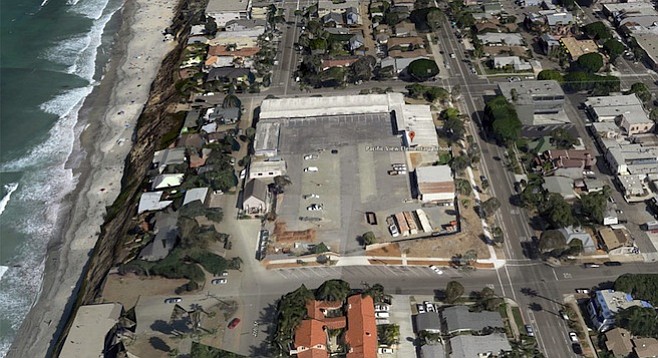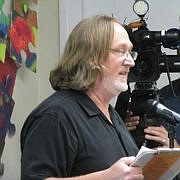 Facebook
Facebook
 X
X
 Instagram
Instagram
 TikTok
TikTok
 Youtube
Youtube

On March 12, the City of Encinitas offered the public their first walk-through of the former Pacific View Elementary School site. The public got see what their $10 million purchased.
Closed since 2003, the 2.8-acre property was saved from the auction block and a future wall of ocean-view condos — by a last-minute deal in 2014, brokered between the city and the Encinitas Union School District.
Over 40 people showed up to inspect, listen, and share ideas on possible plans for the property. The impetus for saving the school, besides keeping public land out of the hands of private developers, was to turn the bluff-top complex into a community arts center.
Perhaps the most jubilant visitor was Scott Chatfield. It was Chatfield who created the website (savepacificview.org) that rallied the community, packed public meetings with supporters, and eventually, with only a few days remaining, stopped the auction and brought the district and the city together in negotiations.
So far, the city seems to be heading in the direction of an arts center. Ed Deane, the city’s deputy director of engineering, said, “The city currently has out a request for proposal for architectural services, to develop plans to make it code compatible, and an inhabitable shell.” The city may look into bringing in a partner to operate the space as a “living museum and cultural art center.”
Artist Danny Salzhandler was perhaps the most vocal of area artists for saving the school. As director of the 101 Artist Colony and the Arts Alive Foundation, he said he hopes for the establishment of a 501(c)3 nonprofit organization to operate of the center, “where all the city’s art organizations would have a seat at the table.”
“Each classroom could soon be a working studio,” Salzhandler said, as he pointed out the possibility of three centuries of education: the original 1883 school house still on the property, the 1950s elementary school, and now a 21st century arts center.
Joining Salzhandler was artist Julia C. R. Gray. Gray was also invested in saving the property, as she had three sons who attended Pacific View Elementary. Her hope is that an artist-in-residency program would be established.
Deane pointed out to the group that in 2016, the city will begin developing a master plan for the entire property. Encinitas TV producer Meredythe Dee Winter hopes to see a state-of the-art media center for TV, music recordings, theater, and performing arts built on the portion of vacant land that was once the school’s playground and parking lot; that portion now serves as leased storage to Leucadia Towing, Encinitas Glass, and the school district’s landscaping equipment.
Built in the 1950s, the seven classrooms seem to have weathered the 12-year vacancy quite well (despite the few broken exterior windows, graffiti, and exterior façade rot). One sign of changing times; large green chalkboards remain in each classroom; in today’s schools, chalk has been replaced by whiteboards.
The school land was originally donated to the community for “public use” in 1883. In the sale to the city, a deed restriction was included for the town’s original one-room schoolhouse, now a museum operated by the Encinitas Historical Society. The building must remain in perpetuity at its location on the corner of E and 4th Streets, the southwest corner of the property.
Working as an arts center sub-committee, city councilpersons Lisa Shaffer and Tony Kranz will update the council and community at the council’s meeting on April 8.

Footnote: Leucadia resident Scott Chatfield is no stranger to quickly organizing the public and changing a bureaucracy’s direction. In 2008, Chatfield posted a “Save the 760 area code” website that generated support from every local business group and elected official, the Marines at Camp Pendleton, along with 6500 residents. The California Public Utilities Commission eventually relented, thus retaining the 760 area code for North County and the Palm Springs/desert areas.


On March 12, the City of Encinitas offered the public their first walk-through of the former Pacific View Elementary School site. The public got see what their $10 million purchased.
Closed since 2003, the 2.8-acre property was saved from the auction block and a future wall of ocean-view condos — by a last-minute deal in 2014, brokered between the city and the Encinitas Union School District.
Over 40 people showed up to inspect, listen, and share ideas on possible plans for the property. The impetus for saving the school, besides keeping public land out of the hands of private developers, was to turn the bluff-top complex into a community arts center.
Perhaps the most jubilant visitor was Scott Chatfield. It was Chatfield who created the website (savepacificview.org) that rallied the community, packed public meetings with supporters, and eventually, with only a few days remaining, stopped the auction and brought the district and the city together in negotiations.
So far, the city seems to be heading in the direction of an arts center. Ed Deane, the city’s deputy director of engineering, said, “The city currently has out a request for proposal for architectural services, to develop plans to make it code compatible, and an inhabitable shell.” The city may look into bringing in a partner to operate the space as a “living museum and cultural art center.”
Artist Danny Salzhandler was perhaps the most vocal of area artists for saving the school. As director of the 101 Artist Colony and the Arts Alive Foundation, he said he hopes for the establishment of a 501(c)3 nonprofit organization to operate of the center, “where all the city’s art organizations would have a seat at the table.”
“Each classroom could soon be a working studio,” Salzhandler said, as he pointed out the possibility of three centuries of education: the original 1883 school house still on the property, the 1950s elementary school, and now a 21st century arts center.
Joining Salzhandler was artist Julia C. R. Gray. Gray was also invested in saving the property, as she had three sons who attended Pacific View Elementary. Her hope is that an artist-in-residency program would be established.
Deane pointed out to the group that in 2016, the city will begin developing a master plan for the entire property. Encinitas TV producer Meredythe Dee Winter hopes to see a state-of the-art media center for TV, music recordings, theater, and performing arts built on the portion of vacant land that was once the school’s playground and parking lot; that portion now serves as leased storage to Leucadia Towing, Encinitas Glass, and the school district’s landscaping equipment.
Built in the 1950s, the seven classrooms seem to have weathered the 12-year vacancy quite well (despite the few broken exterior windows, graffiti, and exterior façade rot). One sign of changing times; large green chalkboards remain in each classroom; in today’s schools, chalk has been replaced by whiteboards.
The school land was originally donated to the community for “public use” in 1883. In the sale to the city, a deed restriction was included for the town’s original one-room schoolhouse, now a museum operated by the Encinitas Historical Society. The building must remain in perpetuity at its location on the corner of E and 4th Streets, the southwest corner of the property.
Working as an arts center sub-committee, city councilpersons Lisa Shaffer and Tony Kranz will update the council and community at the council’s meeting on April 8.

Footnote: Leucadia resident Scott Chatfield is no stranger to quickly organizing the public and changing a bureaucracy’s direction. In 2008, Chatfield posted a “Save the 760 area code” website that generated support from every local business group and elected official, the Marines at Camp Pendleton, along with 6500 residents. The California Public Utilities Commission eventually relented, thus retaining the 760 area code for North County and the Palm Springs/desert areas.
Comments